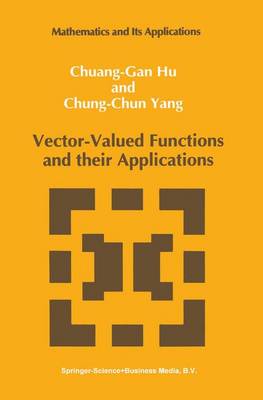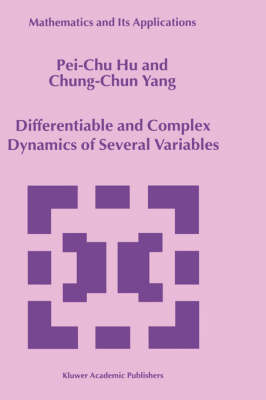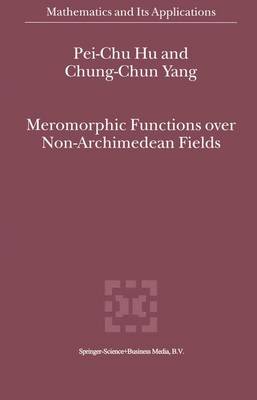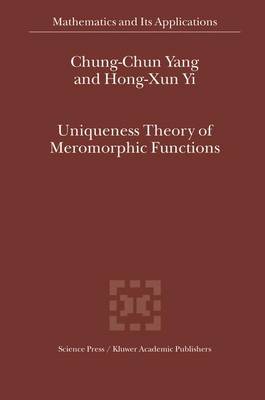Mathematics and Its Applications
4 primary works
Book 3
Vector-Valued Functions and their Applications
by Chuang-Gan Hu and Chung-Chun Yang
Published 31 March 1992
This book is the first to be devoted to the theory of vector-valued functions with one variable. This theory is one of the fundamental tools employed in modern physics, the spectral theory of operators, approximation of analytic operators, analytic mappings between vectors, and vector-valued functions of several variables.
The book contains three chapters devoted to the theory of normal functions, Hp-space, and vector-valued functions and their applications. Among the topics dealt with are the properties of complex functions in a complex plane and infinite-dimensional spaces, and the solution of vector-valued integral equations and boundary value problems by complex analysis and functional analysis, which involve methods which can be applied to problems in operations research and control theory. Much original research is included.
This volume will be of interest to those whose work involves complex analysis and control theory, and can be recommended as a graduate text in these areas.
The book contains three chapters devoted to the theory of normal functions, Hp-space, and vector-valued functions and their applications. Among the topics dealt with are the properties of complex functions in a complex plane and infinite-dimensional spaces, and the solution of vector-valued integral equations and boundary value problems by complex analysis and functional analysis, which involve methods which can be applied to problems in operations research and control theory. Much original research is included.
This volume will be of interest to those whose work involves complex analysis and control theory, and can be recommended as a graduate text in these areas.
Book 483
Differentiable and Complex Dynamics of Several Variables
by Pei-Chu Hu and Chung-Chun Yang
Published 31 July 1999
The development of dynamics theory began with the work of Isaac Newton. In his theory the most basic law of classical mechanics is f = ma, which describes the motion n in IR. of a point of mass m under the action of a force f by giving the acceleration a. If n the position of the point is taken to be a point x E IR. , and if the force f is supposed to be a function of x only, Newton's Law is a description in terms of a second-order ordinary differential equation: J2x m dt = f(x). 2 It makes sense to reduce the equations to first order by defining the velo city as an extra n independent variable by v = :i; = ~~ E IR. . Then x = v, mv = f(x). L. Euler, J. L. Lagrange and others studied mechanics by means of an analytical method called analytical dynamics. Whenever the force f is represented by a gradient vector field f = - \lU of the potential energy U, and denotes the difference of the kinetic energy and the potential energy by 1 L(x,v) = 2'm(v,v) - U(x), the Newton equation of motion is reduced to the Euler-Lagrange equation ~~ are used as the variables, the Euler-Lagrange equation can be If the momenta y written as . 8L y= 8x' Further, W. R.
Book 522
Meromorphic Functions over Non-Archimedean Fields
by Pei-Chu Hu and Chung-Chun Yang
Published 30 September 2000
Nevanlinna theory (or value distribution theory) in complex analysis is so beautiful that one would naturally be interested in determining how such a theory would look in the non Archimedean analysis and Diophantine approximations. There are two "main theorems" and defect relations that occupy a central place in N evanlinna theory. They generate a lot of applications in studying uniqueness of meromorphic functions, global solutions of differential equations, dynamics, and so on. In this book, we will introduce non-Archimedean analogues of Nevanlinna theory and its applications. In value distribution theory, the main problem is that given a holomorphic curve f : C -+ M into a projective variety M of dimension n and a family 01 of hypersurfaces on M, under a proper condition of non-degeneracy on f, find the defect relation. If 01 n is a family of hyperplanes on M = r in general position and if the smallest dimension of linear subspaces containing the image f(C) is k, Cartan conjectured that the bound of defect relation is 2n - k + 1. Generally, if 01 is a family of admissible or normal crossings hypersurfaces, there are respectively Shiffman's conjecture and Griffiths-Lang's conjecture. Here we list the process of this problem: A. Complex analysis: (i) Constant targets: R. Nevanlinna[98] for n = k = 1; H. Cartan [20] for n = k > 1; E. I. Nochka [99], [100],[101] for n > k ~ 1; Shiffman's conjecture partially solved by Hu-Yang [71J; Griffiths-Lang's conjecture (open).
Book 557
Uniqueness Theory of Meromorphic Functions
by Chung-Chun Yang and Hong-Xun Yi
Published 4 October 2004
This book is the first monograph in the field of uniqueness theory of meromorphic functions dealing with conditions under which there is the unique function satisfying given hypotheses. Developed by R. Nevanlinna, a Finnish mathematician, early in the 1920's, research in the field has developed rapidly over the past three decades with a great deal of fruitful results. This book systematically summarizes the most important results in the field, including many of the authors' own previously unpublished results. In addition, useful skills and simple proofs are introduced. This book is suitable for higher level and graduate students who have a basic grounding in complex analysis, but will also appeal to researchers in mathematics.



